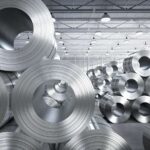Carbon steel is steel in which the main interstitial alloying constituent is carbon in the range of
0.12–2.0%. The American Iron and Steel Institute (AISI) defines carbon steel as the following: “Steel is considered to be carbon steel when no minimum content is specified or required for chromium, cobalt, molybdenum, nickel, niobium, titanium, tungsten, vanadium or zirconium, or any other element to be added to obtain a desired alloying effect; when the specified minimum for copper does not exceed 0.40 percent; or when the maximum content specified for any of the following elements does not exceed the percentages noted: manganese 1.65, silicon 0.60, copper
0.60.
Types:
Carbon steel is broken down into four classes based on carbon content:
Mild and low-carbon steel
Mild steel also known as plain-carbon steel, is the most common form of steel because its price is relatively low while it provides material properties that are acceptable for many applications, more so than iron. Low-carbon steel contains approximately 0.05–0.320 % carbon making it malleable and ductile. Mild steel has a relatively low tensile strength, but it is cheap and malleable; surface hardness can be increased through carburizing.
It is often used when large quantities of steel are needed, for example as structural steel. The density of mild steel is approximately 7.85 g/cm3 (7850 kg/m3 or 0.284 lb/in3) and the Young’s modulus is 210 GPa (30,000,000 psi).
Low-carbon steels suffer from yield-point run out where the material has two yield points. The first yield point (or upper yield point) is higher than the second and the yield drops dramatically after the upper yield point. If low-carbon steel is only stressed to some point between the upper and lower yield point then the surface may develop louder bands. Low-carbon steels contain less carbon than other steels and are easier to cold-form, making them easier to handle.
Higher carbon steels
Carbon steels which can successfully undergo heat-treatment have carbon content in the range of
0.30–1.70% by weight. Trace impurities of various other elements can have a significant effect on the quality of the resulting steel. Trace amounts of sulfur in particular make the steel red- short, that is, brittle and crumbly at working temperatures. Low-alloy carbon steel, such as A36 grade, contains about 0.05% sulfur and melts around 1,426–1,53°C (2,599–2,800°F). Manganese is often added to improve the harden ability of low-carbon steels. These additions turn the material into low-alloy steel by some definitions, but AISI’s definition of carbon steel allows up to 1.65% manganese by weight.
Low carbon steel
Less than 0.3% carbon content
Medium carbon steel
Approximately 0.30–0.59% carbon content. Balances ductility and strength and has good wear resistance; used for large parts, forging and automotive components.
High-carbon steel
Approximately 0.6–0.99% carbon content. Very strong, used for springs and high-strength wires.
Ultra-high-carbon steel
Approximately 1.0–2.0% carbon content. Steels that can be tempered to great hardness. Used for special purposes like (non-industrial-purpose) knives, axles or punches. Most steels with more than 1.2% carbon content are made using powder metallurgy. Note that steel with carbon content above 2.14% is considered cast iron.


